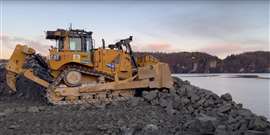Read this article in Français Deutsch Italiano Português Español
Remote-controlled dozer for Norway’s largest earthmoving project
21 January 2025
Technology company Steer has delivered a remote-controlled Caterpillar D8 dozer to Hæhre – one of Norway’s leading civil engineering contractors – which is now being used for extensive marine filling work at Frier Vest in Grenland, Norway.
 A remote-controlled Caterpillar D8 dozer is being used at a site in Norway to increase safety. Image: Steer
A remote-controlled Caterpillar D8 dozer is being used at a site in Norway to increase safety. Image: Steer
The project is Norway’s largest earthmoving operation, resulting in 3,700 acres of commercial land and a port terminal.
The remote-controlled dozer is used to manage material from up to 14 dump trucks (Caterpillar 772G, 775G, and electric Sany trucks) at the marine filling site. The trucks unload their loads inland, and the dozer pushes the material outwards. The dozer operator works approximately 500m away from the machine, eliminating the risks associated with landslides and collapse.
“This technology allows us to efficiently deliver on demanding projects without jeopardizing operator safety,” says Asle Ståland, Project Director at Hæhre. “The experience has been very positive so far. Operators find the solution easy to use and comfortable.”
The efficiency of the remote-controlled dozer is said to be fully maintained, operating just as effectively as if it had an onboard driver. Steer has integrated Trimble machine control into the system, enabling the dozer blade to be automatically controlled via GPS.
Njål Gjermundshaug, CEO of Steer, emphasises that the technology has been thoroughly tested over several years and finally looks set to become a standard for marine filling projects.
“It’s a much safer method than equipping operators with life vests, oxygen tanks, and mechanisms for automatic window breaking,” says Gjermundshaug.
Steer, Hæhre, and RG have collaborated on developing the dozer and the operator station. Espen Holte, technical lead at Hæhre, notes that only minor adjustments remain to meet operator preferences, including fine-tuning the seat and controls.
Gjermundshaug adds that there is significant interest in similar solutions for quarries and mines, where one operator can switch between controlling several loaders and dozers at dumping sites.
STAY CONNECTED


Receive the information you need when you need it through our world-leading magazines, newsletters and daily briefings.
CONNECT WITH THE TEAM











